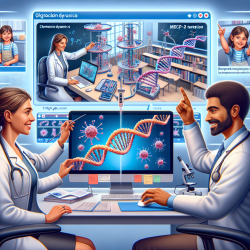Introduction
In the evolving field of pharmacogenomics (PGx), the interaction between drugs and genes is a critical area of study. The research article "Lay understandings of drug-gene interactions: The right medication, the right dose, at the right time, but what are the right words?" by Meagher et al. (2022) sheds light on how patients perceive these interactions and the implications for effective communication. As practitioners, understanding these insights can significantly enhance the delivery of therapy services, particularly in online settings like those provided by TinyEYE.
Understanding the Research
The study conducted by Meagher et al. involved focus groups to explore how individuals understand PGx results. The findings highlighted three main themes:
- Health Implications: Participants generally understood the health implications of PGx results, distinguishing them from disease susceptibility genetic results.
- Conflation with Other Medical Reactions: There was a tendency among participants to conflate drug-gene interactions with allergies or other medical reactions.
- Communication Framework: The study suggested moving beyond a deficit model of genetic literacy, emphasizing the need for a bidirectional communication framework.
Implications for Practitioners
For practitioners, these findings underscore the importance of clear and effective communication when discussing PGx results with patients. Here are some strategies to consider:
- Use Clear Language: Avoid technical jargon and use language that patients can easily understand. This approach can help prevent misconceptions and improve patient engagement.
- Encourage Questions: Foster an environment where patients feel comfortable asking questions. This dialogue can clarify misunderstandings and reinforce patient comprehension.
- Visual Aids and Analogies: Utilize visual aids and analogies to explain complex concepts. These tools can make abstract ideas more concrete and relatable for patients.
Encouraging Further Research
While the study provides valuable insights, it also highlights the need for ongoing research into effective communication strategies in PGx. Practitioners are encouraged to engage in further research and training to stay abreast of best practices in this rapidly evolving field.
Conclusion
Effective communication is pivotal in the successful implementation of pharmacogenomics in clinical practice. By applying the insights from Meagher et al.'s research, practitioners can enhance patient understanding and outcomes, ultimately leading to more personalized and effective therapy services.
To read the original research paper, please follow this link: Lay understandings of drug-gene interactions: The right medication, the right dose, at the right time, but what are the right words?










